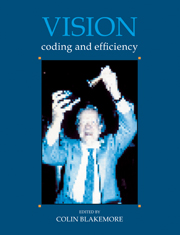Book contents
- Frontmatter
- Contents
- List of Contributors
- Preface
- Reply
- Acknowledgements
- Concepts of coding and efficiency
- Efficiency of the visual pathway
- Colour
- Brightness, adaptation and contrast
- Development of vision
- Depth and texture
- 26 Is there a single, most-efficient algorithm for stereopsis?
- 27 Binocular mechanisms in the normal and abnormal visual cortex of the cat
- 28 Viewing geometry and gradients of horizontal disparity
- 29 Texture discrimination: radiologist, machine and man
- Motion
- From image to object
- Index
26 - Is there a single, most-efficient algorithm for stereopsis?
Published online by Cambridge University Press: 05 May 2010
- Frontmatter
- Contents
- List of Contributors
- Preface
- Reply
- Acknowledgements
- Concepts of coding and efficiency
- Efficiency of the visual pathway
- Colour
- Brightness, adaptation and contrast
- Development of vision
- Depth and texture
- 26 Is there a single, most-efficient algorithm for stereopsis?
- 27 Binocular mechanisms in the normal and abnormal visual cortex of the cat
- 28 Viewing geometry and gradients of horizontal disparity
- 29 Texture discrimination: radiologist, machine and man
- Motion
- From image to object
- Index
Summary
Introduction
It can be argued that stereopsis has evolved on at least three separate occasions; in mammals, in birds and in machines (see Bishop & Pettigrew, 1986; Pettigrew, 1986). While the evolution of machine algorithms for stereopsis is still occurring, such algorithms have reached a level of sophistication where comparison with animals can be made (see Poggio & Poggio, 1984). When the mammalian, avian and machine systems for stereopsis are compared, some fundamental similarities in organisation emerge despite the many structural differences. In particular, all three systems appear to delay image processing until after information from both eyes is brought together. The surprising fact that stereopsis can occur without prior monocular pattern recognition was already recognised from psychophysical studies on humans and was reinforced by detailed studies of the neural machinery underlying stereopsis in both mammals and birds, not to mention the more recent machine algorithms which also avoid complex form analysis prior to extraction of the stereoscopic information. This chapter deals with the possible reasons behind this common feature of successful stereoscopic systems. Two general lines of argument will be advanced;
i. If the primary role of stereopsis is not the judgement of depth but rather the detection of edges which are invisible to monocular inspection, it is necessary that this edge-detection step precede any attempts at form analysis. This is a teleological argument which can be supported by an examination of the evolutionary context within which some avian groups have acquired stereopsis while other close relatives have not.
[…]
- Type
- Chapter
- Information
- VisionCoding and Efficiency, pp. 283 - 290Publisher: Cambridge University PressPrint publication year: 1991
- 1
- Cited by



